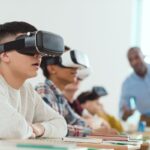Throughout our history, few threads have been woven as quickly or as disruptively as digital technology. In just a few short decades, we’ve transitioned from a world where a computer was a room-sized luxury, to one where a powerful computer sits in almost every pocket. Evolution has led to a unique generational divide: the Digital Natives and the Digital Immigrants.
Table of Contents
Understanding Digital Natives and Digital Immigrants

Digital Natives are the younger generation, born into the digital age, for whom technology is a natural part of life. They’ve grown up with smartphones, social media, and the internet as a ubiquitous presence. On the other hand, Digital Immigrants are those who were introduced to digital technology in their adult lives. They’ve had to adapt to this new world, learning to navigate the digital landscape later in life.
The Technological Proficiency Gap

While it’s often assumed that Digital Natives are inherently tech-savvy and Digital Immigrants struggle with technology, the reality is more nuanced. Proficiency with technology is not just about age, but also about exposure, interest, and the willingness to learn and adapt.
Bridging the Gap in the Workplace

The workplace is a common battleground for the generational digital divide. Digital Natives often bring a fresh perspective and are comfortable with newer technologies and social media platforms. However, Digital Immigrants bring valuable experience and may have a better understanding of traditional business models and practices.
The Role of Education

Education plays a crucial role in bridging the digital divide. Schools and universities are tasked with preparing Digital Natives for the future while also providing Digital Immigrants with the tools they need to adapt and thrive in a digital world.
The Social Media Divide

Social media is a clear demarcation line between Digital Natives and Digital Immigrants. While the former are often fluent in the language of likes, shares, and tweets, the latter may not engage as much with these platforms. However, both groups can learn from each other’s approach to online interaction.
The Importance of Mutual Respect and Understanding

Bridging the digital divide is not just about teaching Digital Immigrants how to use a smartphone or explaining to Digital Natives the value of face-to-face communication. It’s about fostering an environment of mutual respect and understanding, where each group acknowledges the strengths and perspectives of the other.
The Power of Reciprocal Learning

Digital Natives and Digital Immigrants have much to learn from each other. Digital Immigrants can guide Natives in understanding the world that existed before the digital revolution, while Natives can help Immigrants navigate the digital landscape.
The Challenge of Cybersecurity

Cybersecurity is a concern for both Digital Natives and Digital Immigrants. While Natives may be more comfortable online, they can also be more complacent about online risks. Immigrants, while perhaps more cautious, may not be aware of all the potential threats.
The Future of the Digital Divide

As technology continues to evolve, the digital divide may shift and change. Future generations may face new divides based on different technologies or digital trends. It’s important to continue the dialogue and education to bridge these gaps.
Embracing the Digital Melting Pot

The digital world is a melting pot of generations, experiences, and skills. By understanding and embracing this, we can bridge the digital divide, fostering a world where Digital Natives and Digital Immigrants work together to shape the future of the digital landscape.








